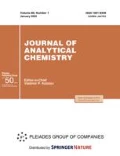Abstract
It was shown that the use of pentavalent vanadium salts in liquid-phase oxidation significantly extends the field of their application in organic analysis. Oxidation at elevated temperatures (200–230°C) has become possible under conditions not studied previously and favorable from an analytical viewpoint. Any organic compounds were decomposed to the final oxidation products (CO2 , H2O, and, when a molecule contains the amine nitrogen, NH3). The quantity of the analyte can be easily determined from the amount of vanadate consumed for the oxidation. Using numerous compounds from different classes as examples, we have demonstrated that wet combustion at elevated temperatures holds much promise. The method is easy to perform; it is highly sensitive and can be assigned to micro- or semimicroanalytical methods, because analyte samples are varied in the range of several milligrams.
Similar content being viewed by others
REFERENCES
Ashworth, M.R.F., Titrimetric Organic Analysis, New York: Interscience, 1965. Translated under the title Titrimetricheskie metody analiza organicheskikh soedinenii, Moscow: Khimiya, 1972.
Berka, A., Vulterin, J., and Zyka, J., Newer Redox Titrants, International Series of Monographs in Analytical Chemistry, vol. 22, New York: Pergamon, 1965. Translated under the title Novye red-oks metody v analiticheskoi khimii, Moscow: Khimiya, 1968.
Syrokomskii, V.S. and Klimenko, Yu.V.Vanadatometriya (Vanadatometry), Sverdlovsk: Gos. Izd. Chernoi Tsvetnoi Metallurgii, 1950.
Berg, R., “Oxin,” Shtuttgart: Ferdinand Enke, 1935. Translated under the title Primenenie o-oksikhinolina v analiticheskoi khimii Moscow: Otd. Nauchn. Tekh. Inform., Glavnaya Redaktsiya Khimicheskoi Literatury, 1937.
Vinogradov, A.V. and Elinson, S.V., Oksikhinolin (Hydroxyquinoline), Moscow: Nauka, 1979.
Rao, S.P., Rathi, H.S., and Gaur, J.N., Anal. Chem. Acta, 1961, vol. 25, no. 2, p. 136.
Payasi, A.P., Sharma, K., and Sharma, V.K., J. Indian Chem. Soc., 1987, vol. 64, no. 3, p. 186.
Woodbridge, J.E. US Patent 3467499, 1970.
Datsko, V.G. and Kaplap, V.T., in Sovremennye metody analiza prirodnykh vod (Modern Methods of Water Analysis), Moscow: Akad. Nauk SSSR, 1962, p. 118.
Yanson, E.Yu. and Ievin'sh, A.F., Usp. Khim., 1959, vol. 18, no. 8, p. 980.
Author information
Authors and Affiliations
Rights and permissions
About this article
Cite this article
Zhivopistsev, V.P., Aramelev, A.S. Vanadatometry in Organic Analysis. Journal of Analytical Chemistry 57, 832–835 (2002). https://doi.org/10.1023/A:1020040127036
Issue Date:
DOI: https://doi.org/10.1023/A:1020040127036




